The Wheelchair Guide
Your Wheelchair and Mobility Scooter Resource
A Basic Guide to Manual and Electric Wheelchairs
Wednesday, May 12th, 2010
 A wheelchair might seem like a rather straightforward device, but there are many parts that go into a modern wheelchair, with some helping to improve the wheelchairs performance, as well as making it easier to use.
A wheelchair might seem like a rather straightforward device, but there are many parts that go into a modern wheelchair, with some helping to improve the wheelchairs performance, as well as making it easier to use.
Traditional Manual Wheelchairs
Today, most manual wheelchairs use a design that is based, at least in part, on the E&J wheelchair, which was developed right before WWII. Not everyone is familiar with the E&J Wheelchair, which is the name of its inventors, Everest and Jennings, but most people have seen them. This is the design that uses hollow metal tubes in the frame and a vinyl seat, which allows the wheelchair to be folded when not in use.
The innovation of this lightweight folding wheelchair made it much easier for those who used wheelchair to be get around when it was first developed, as most other wheelchairs were made of heavy wood and other bulky materials. This not only made it difficult to transport early wheelchairs, but it also made it hard for users to self-propel their wheelchair. The E&J Wheelchair solved these problems and its effect on the modern manual wheelchair can still be seen today.
Sports Wheelchairs
Of course, the sports wheelchair is becoming much more popular, which is a lightweight wheelchair, with performance in mind. There are many different types of wheelchair sports, with many sports having a special wheelchair design. For instance, the wheelchairs used in wheelchair basketball are surrounded by a protective cage and metal bumpers to prevent injuries.
However, there are many much more generic sports wheelchairs around, which are not necessarily designed for a specific sport, but instead include a number of performance features. This includes things like adjustable axles, smaller seats, low profile foot rigging, and many other performance tweaks that make it very maneuverable and fast. Many wheelchair users prefer the sports wheelchair design to that of a traditional folding wheelchair. As an example, most sports wheelchairs have a much lower back, which can make it much easier to turn and reach things behind you.
Electric Wheelchairs
While manual wheelchairs remain very popular, they require a good deal of energy to use, requiring that the person is fit and in good shape. This requires a lot of upper body strength and this is a factor that leads some to use Electric Wheelchairs, although a lot of people simply prefer a power chair to a manual wheelchair.
Power chairs utilize an electric motor and rechargeable battery, being very well suited for indoor use. Most preform well on packed ground as well, but some are more suited for outdoor use than others. Electric wheelchairs are more expensive than manual wheelchairs, but most travel over five miles on a single charge, which is no small task in a manual wheelchair.
There are several types of electric wheelchairs, but two of the most common are the rear-wheel drive wheelchair and the mid-wheel drive wheelchair. A rear wheel drive electric wheelchair provides a slightly stabler base and is a little bit better suited for outdoor use than a mid-wheel drive wheelchair. However, because the drive wheel in a mid-wheel drive wheelchair is located at the center of the device, they are often much more maneuverable.
Folding electric wheelchairs, as well as travel wheelchairs that can be taken apart are also available, which are not as high performance as regular power chairs, but are designed to be transported without a wheelchair lift.
For many, the wheelchair remains one of the most well known and common types of mobility vehicles, providing a service that is different from that of something like a mobility scooter. Wheelchairs have a rich history of innovation and are as common today, as they were 100 years ago.
Manual Wheelchairs vs Electric Wheelchairs: A Buyers Guide
Monday, January 4th, 2010
Wheelchairs are important safety tools that are used by those who are unable to walk or have difficulty doing so. While the wheelchair has roots that date back thousands of years, modern wheelchairs are based off of a hollow steel tube design that was developed during the 1930′s. This design remains popular today and helps keep the weight of the wheelchair down, without sacrificing its strength.
While the folding steel tube manual wheelchair is still very common, many wheelchair users prefer electric wheelchairs. Electric wheelchairs offer the same basic functionality that manual wheelchairs offer, except they are operated electronically. Electric wheelchairs also have a design that is much different than a manual wheelchair is.
How Manual Wheelchairs are Designed
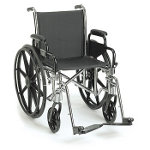 A manual wheelchair usually has a wide chair, with two large wheels on either side and two small wheels in front. The larger wheels have handrails that extend off of the wheel and allow the user to move the wheels, without having to actually touch that part f the wheel that makes contact with the ground.
A manual wheelchair usually has a wide chair, with two large wheels on either side and two small wheels in front. The larger wheels have handrails that extend off of the wheel and allow the user to move the wheels, without having to actually touch that part f the wheel that makes contact with the ground.
Many manual wheelchairs also have push handles that extend backwards from the top of the chairs seat, allowing someone to push the wheelchair from behind.
While most manual wheelchairs are designed to be self-propelled, which is why they have the larger rear wheels, some wheelchairs are only designed to be pushed. These wheelchairs, which are sometimes called transfer wheelchairs or transport wheelchairs, have much smaller wheels.
Sports wheelchairs are also very popular and come in a variety of designs. Some, like those used during wheelchair basketball or wheelchair rugby, are very specialized. For example, since wheelchair basketball can be so dangerous, a wheelchair basketball sports wheelchair will have a guard around the entire wheelchair. Another example of a specialized sports wheelchair is those used for wheelchair racing, which have a much longer wheelbase than other wheelchairs.
Other sports wheelchairs offer a much less specialized design, with a focus more on being lightweight and small, while allowing for optimal turning and speed. These are a popular choice by many wheelchair users, even those who do not actually play wheelchair sports.
How Electric Wheelchairs Are Designed?
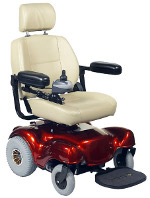 Electric Wheelchairs, on the other hand, are not intended to be self-propelled and are instead operated using a rechargeable battery. As a result, they only have a limited range before the battery must be recharged.
Electric Wheelchairs, on the other hand, are not intended to be self-propelled and are instead operated using a rechargeable battery. As a result, they only have a limited range before the battery must be recharged.
The weight of the rider as well as what type of terrain is driven over can affect the wheelchairs per-charge range. So, for example, driving up hill will wear the battery out quicker than driving it on level ground. With that said, many have ranges that are over 8 miles per charge, which is a fairly large distance for most people.
Unlike manual wheelchairs, the wheelbase of an electric wheelchair is very small. Some have four small wheels, with the rear wheels being responsible for actually moving the wheelchair. Other power chairs use a mid-wheel drive system, with a set of wheels in the front and back that provide support, while the set of wheels in the middle are responsible for moving the chair. Usually a mid-wheel drive power chair is much more maneuverable than a rear-wheel drive power chair.
Atop of the plastic base of the power chair, a captains chair is installed. Usually the captains chair is designed similarly to an office chair. The armrests can be folded up and the actual control system is placed on either the right or left armrest. The chair can also be pivoted to make it easier to enter and exit the wheelchair.
Like office chairs, the style of the captains chair varies depending on the model of the electric wheelchair. For instance, some will have a much higher back with head and neck support, while others have a considerably lower back without any neck support.
What is Best For Me?
Often, choosing between a power chair or a manual wheelchair comes down to personal preference. For instance, many prefer the physical effort that is required to use a manual wheelchair, while others find that it is too strenuous.
Cost is also a factor, as you can usually find a quality manual wheelchair for less than $500, while an electric wheelchair usually starts at $1500 and goes up from there.
It is also important to consider where you will be using the wheelchair, as if you are only planning on using it around the home, an electric wheelchair could be overkill. On the other hand, someone going to school and traveling across campus daily might prefer an electric wheelchair.
Transporting the wheelchair is another concern. Most manual wheelchairs are designed to be folded when not in use. This allows them to be stored in the trunk of a car or even the backseat with little difficulty. Electric wheelchairs, on the other hand, are considerably heavier and will often require some sort of wheelchair lift is installed onto the automobile.
Another consideration is that a Manual Wheelchair will almost always work, providing it is regularly maintenance. An electric wheelchair is more prone to mechanical or electrical failure, as well as being more sensitive to rain and other elements. As a result, a manual wheelchair often provides a much more long term and dependable option, without the need for replacing batteries or other maintenance that is required on a power chair.
The History of the Modern Wheelchair
Saturday, November 14th, 2009
Wheelchairs have become one of the most common types of mobility vehicles and are used by people in every country in the World. However, unlike many other types of inventions, the wheelchair is relatively new and the modern wheelchair is actually less than 100 years old.
When the history of the wheelchair is considered, records can be traced back thousands of years that describe devices that were used by people who were unable to or had difficulty walking. These early devices are classified as wheelchairs, but when you consider their design and the way they were used, they are incredibly different from the modern wheelchair. In these early times, building and constructing a wheelchair was very expensive and often something that was only available to royalty.
It was also very common for early wheelchairs to work more as carts or even prams, in that the person using the wheelchair had to be pushed around by others. There were, of course, several early self propelled wheelchairs, but these often used hand cranks and were more of a novelty for kings, rather than a tool for the disabled.
Towards, the end of the nineteenth century and the early twentieth century, wheelchair design began to become more standardized, in part due to lessons learned during the civil war. It was during this time that the wicker wheelchair became very popular. These wheelchairs had two wheels on the side, with a third wheel in back for support. The wheelchair itself was mostly made out of wicker, which is a made of weaving fiber together to form a strong rigid material.
The wicker wheelchairs had a very long back and were rather cumbersome. Even though they often had larger wheels on the sides, it was seldom easy or even possible to self-propel with this type of wheelchairs. Also, due to their large size, transporting a wicker wheelchair was simply not something that could be done easily or without expending abnormal resources.
Still, the design of the wicker wheelchair worked very well and hospitals all over the country adopted this design. Some people would also construct wooden wheelchairs, using a similar design to the wicker chair, only using boards of wood instead of wicker.
Wicker wheelchairs would remain popular for about twenty years, up until the mid-thirties, when a new type of wheelchair was developed. It was at this time when the E&J wheelchair was developed, which would revolutionize wheelchair design. The E & J wheelchair was designed by two inventors named Everest and Jennings.
Herbert Everest was an engineer who had suffered a back injury and was confined to a wheelchair. Together with Jennings, another Engineer, Everest set out to address several issues that made using a wheelchair in the 1930′s very difficult. Specifically they developed a folding lightweight wheelchair, which could be easily traveled with.
The E&J wheelchair used hollow metal tubes to provide excellent strength and support, without adding too much weight. It also featured large wheels on the side, which could be self propelled, by the user. Today, this design is still used and its influence can be seen in almost all manual wheelchairs.
Self-Propelled Wheelchairs and Power Chairs
Monday, October 12th, 2009
Over the history of mankind, there have always been inventions that are designed to help those who can not walk. In the grand scheme of things these devices are considered to be wheelchairs, but they are not usually what most people think of as a wheelchair. Instead, the hollow tubbed metal frame with its vinyl seats that most people first think of when considering a wheelchair is a new invention that has been around for less than 100 years.
Today, there are countless models and brands of wheelchairs, enough that it can almost be overwhelming when trying to shop for a wheelchair, but they all share a very similar design. This is not only true of most manual wheelchairs, but also electric wheelchairs.
Basic Manual Wheelchair Design
Most self-propelled manual wheelchairs have two rear wheels that are larger in size. The rear wheels have another smaller rim attached to the outside of the wheel, which allows the user to spin the wheel, without having to actually touch that parts that makes contact with the ground.
Most manual wheelchairs also have a set of push handles attached to the frame of the wheelchair, which allow it to be pushed easily. Transfer wheelchairs, which are not designed to be self-propelled, do not usually have handrims on the rear wheel and instead the rear wheels are only slightly larger than the front wheels.
The Folding Wheelchair Frame
The typical manual wheelchair is also designed to be folded when not in use, which allows it to be placed in the rear of a car without the need of a vehicle wheelchair use. This also makes them well suited for traveling. The frame of the wheelchair is made out of hollow tubes of metal, with steel being the most common type, which is very sturdy and lightweight. Other metals are also sometimes used, but they tend to be more expensive, with the main advantage of these alternate metals being their lightweight. Many sports wheelchairs will make use of a non-steel metal.
Differences Between Manual and Electric Wheelchairs
While electric wheelchairs no longer use a design that is very similar to a manual wheelchair, they do all standard design. Most consist of a small plastic base, which houses the electric motor, rechargeable batteries, axles, and other electrical components. The chair is attached to the base of the wheelchair and armrest controls are usually attached, using a simple joystick control scheme. This allows the wheelchair to be controlled by simply pushing the joystick in the desired direction. The joystick can be configured for either right hand or left hand use, by simply changing which side of the armrest it is attached to.
Of course, there are a number of people who can not use the standard wheelchair control, so there are a number of alternative wheelchair controls available. This includes wheelchairs that are controlled by head movements, the users breath, and even by remote control.
In the case of electric wheelchairs, they can usually travel between 4 and 8 miles per charge, although this is something that varies depending on the weight of the user and the type of terrain the wheelchair is driven over. For instance, driving an electric wheelchair up a hill repeatedly will wear it down faster than if it were driven across flat ground.
Choosing Between a Manual Wheelchair and a Power Chair
Tuesday, September 15th, 2009
In today’s world, the choice of manual or electric often gets looked upon as an easy choice, with power almost always getting looked upon as the easier and more efficient solution. This can be seen in most peoples choice of power tools, power windows, and power steering. However, in the world of manual and electric wheelchairs, the choice is not so straightforward or easy, as both have advantages and disadvantages.
A Look Back at the History of the Wheelchair
Wheelchairs have been used for thousands of years, with images being found that indicate ancient Asians were among some of the first to make use of a wheelchair for those who had difficulty walking. During the middle ages, wheelchairs would be relatively common, but because they had to be custom made, they were almost only available to those who had the resources to build them, such as figures of nobility.
It would not be until much later during the early nineteenth century that wheelchairs would take on a more standard design, using a simple foldable lightweight steel tube frame. Today, this same design remains incredibly popular among manual wheelchairs and electric wheelchairs are also very common, with an electric motor concealed in a base made of molded plastic and a seat attached to the base of the wheelchair.
Choosing the Right Wheelchair: The User
One of the first , and arguably most important, steps in deciding whether to use a manual wheelchair or an electric wheelchair revolves around the physical abilities of the wheelchair user. It takes a great deal of physical effort to use a manual wheelchair and this can put a great deal of stress on the upper-body. As a result, using a manual wheelchair can be very strenuous, too much so for many
There is of course also something to be said for personal preference, as many people enjoy using a manual wheelchair precisely because it requires more physical effort. There are a number of sports, such as wheelchair basketball, wheelchair tennis, and wheelchair racing, which make extensive use of manual wheelchairs as well and many wheelchair users prefer the feeling of independence and flexibility that is offered by using a manual wheelchair. .
Choosing the Right Wheelchair: The Location
While the physical condition of the wheelchair user is one of the most important considerations, the location where the wheelchair will be used is also important. For example, if the wheelchair is primarily going to be used around home, then it will require much less upper-body strength to use than if it were to be used around a college campus. As a result, for home use, many people prefer the simple and less complicated design of a manual wheelchair.
However, those that will be using the wheelchair across larger distances, such as around town or driving around the neighborhood, might be better served with an electric wheelchair.
Choosing the Right Wheelchair: The Cost
One of the other major considerations when choosing between an electric wheelchair or a manual wheelchair is the cost of the device. While it is possible to spend a great deal on a manual wheelchair, they still typically cost a great deal less than an electric wheelchair. For those who are unable to get a Medicare wheelchair, Medicaid Wheelchair, or other insurance discount, an electric wheelchair might simply not be affordable.
A Look at Wheelchair Development
Friday, September 11th, 2009
Mobility vehicles of some shape or form have been around for hundreds and thousands of years. These devices are important tools for increasing accessibility and allowing those who have difficulty walking to get around.
Early Wheelchair Design
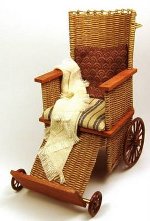 In the early days, there was no standard to these devices and often they were only affordable by nobility. It was also not uncommon for the kings and other royalty who used these early wheelchairs to need them more as a result of their lavish lifestyle, rather than out of a practical need.
In the early days, there was no standard to these devices and often they were only affordable by nobility. It was also not uncommon for the kings and other royalty who used these early wheelchairs to need them more as a result of their lavish lifestyle, rather than out of a practical need.
This began to change towards the end of the nineteenth century, when a wicker wheelchair was designed. The wicker wheelchair had a very high back and sides, with two wheels on the side and one in the back. Due to its large size and the design of its wheels, it was very hard for a wheelchair user to self propel this type of wheelchair or even to transport it away from the hospital. Still, it was much more effective than previous designs and was adopted across the United States by most hospitals.
The Development of the Folding Self-Propelled Wheelchair
 The wicker wheelchair had a number of design problems that made it very difficult for the average wheelchair user to use. As a result, two inventors, one of whom was in a wheelchair, worked together to develop a lightweight foldable wheelchair. Their design, which is known as the E & J wheelchair, made use of a frame made out of hollow steel tubes, which provided a great deal of support and strength, but without the same weight as that of a wicker wheelchair. The steel tube frame could also be folded up, making the wheelchair much easier to transport.
The wicker wheelchair had a number of design problems that made it very difficult for the average wheelchair user to use. As a result, two inventors, one of whom was in a wheelchair, worked together to develop a lightweight foldable wheelchair. Their design, which is known as the E & J wheelchair, made use of a frame made out of hollow steel tubes, which provided a great deal of support and strength, but without the same weight as that of a wicker wheelchair. The steel tube frame could also be folded up, making the wheelchair much easier to transport.
At the time the E & J wheelchair was invented, America was on the precipice of the Second World War and so the wheelchair was put to great use. The development of antibiotics meant that soldiers were able to recover from wounds that even only a few short years ago would have been fatal, with many soldiers returning from the war without full use of their legs.
The E & J wheelchair would remain the standard for some time and the first electric wheelchairs were built around its frame. A number of companies began to sell converter kits that allowed the E & J wheelchair to be inexpensively converted to an Electric Wheelchair. These made use of a simple electric motor that could be attached to the axle of the wheelchair and controlled by a simple joystick placed on the wheelchair’s arm. While the design of a modern electric wheelchair is much different, the joystick control scheme is the standard for most electric wheelchairs. However, there are also a number of other control systems available for those who can not use a joystick.
Today, the basic design of the E & J wheelchair has remained the same and can be seen in most modern manual wheelchairs, although there are many other popular wheelchair manufacturers.
The History of the Modern Manual Wheelchair
Friday, August 21st, 2009
Manual wheelchairs are one of the oldest types of wheelchairs known to man and records of their use can be traced back thousands of years. However, up until the end of the nineteenth century, there was very little standardization when it came to manual wheelchairs and they were often only available to people who had the resources to hire a professional builder.
Wicker and Wood: Early Wheelchair Designs
Towards the end of the nineteenth century, however, the wicker basket wheelchair began to become very popular. These wheelchairs provided a wicker seat for the person using the wheelchair, which had a very long and high back. These wicker wheelchairs had three wheels and were not only incredibly bulky, but also very heavy.
As a result of how these wheelchairs were designed, it was very difficult to transport a wicker wheelchair and it was also very difficult for the person using the wheelchair to move it on their own. Instead, they were forced to rely on nurses and family members to push the wheelchair if they wanted to move around.
In addition to the wicker wheelchairs, there were also several popular wooden wheelchairs, which were also incredibly heavy and difficult to transport, but were easier to self propel than the wicker wheelchair.
The Development of a Lighter Easier to Use Manual Wheelchair
Despite all their flaws, the wicker wheelchair would remain the standard in wheelchair design for over two decades until the 1930′s, when the first foldable tube framed manual wheelchair was developed. This new wheelchair was created by two inventors named Everest and Jennings and would come to be called the E & J Wheelchair.
Harry Jennings set out to build a newer lightweight wheelchair when he saw the difficulties his friend Herbert Everest was having using the standard wicker wheelchair. Together, they came up with a very innovative wheelchair design, which used hollow metal tubes and a foldable frame. By using metal tubes, they were able to create an incredibly strong wheelchair frame, which was also relatively lightweight.
The E & J Wheelchair frame could also be folded up and placed in a carriage or other vehicle, making easily traveling with a wheelchair possible for the first time. As the E & J Wheelchair was being developed, the build up to the Second World War was beginning and the E & J Wheelchair would soon have a number of users.
The First Electric Wheelchairs
The E & J wheelchair was also used as the base of the first electric wheelchair, when inventors in the 1950′s developed an electric motor that could be attached to the frame of an E & J wheelchair. This allowed the E & J wheelchair to be easily turned into an electric power chair and several companies began selling conversion kits for the E & J Frame.
The Wheelchairs of Today
The E & J manual wheelchair quickly became the standard and was used worldwide. Today, E & J wheelchairs are still available and their influence can be seen in virtually all modern manual wheelchairs.
Choosing the Right Electric Power Wheelchair
Friday, August 14th, 2009
For wheelchair users, the choice between an electric wheelchair and a manual wheelchair often revolves around the physical abilities of the wheelchair user. However, there are a number of other considerations, including personal preference, budget, and the place the wheelchair will be used.
For those that have decided to invest in an electric wheelchair, selecting the right power chair is very important, so it is important to understand some of their features and some of the different types of electric wheelchairs.
Rear-Wheel Drive Power Chairs vs Mid-Wheel Drive Power Chairs
There are several ways to categorize electric wheelchairs, but the drive system is one of the most important considerations. Power chairs are either driven by a mid-wheel drive system or a rear-wheel drive system. Understanding the difference between the two is important, because they both offer advantages and disadvantages.
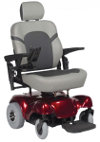 A rear-wheel drive power chair, as the name implies is driven by the rear wheels. Rear-wheel drive power chairs typically have only two sets of wheels, one in the front and one in the back, with the back wheels being responsible for moving the wheelchair. They may also have anti-tip casters, but as far as actual weight bearing wheels, there are usually only four. Since the weight of the wheelchair user is spread out evenly amongst the four wheels, the rear wheel drive system provides a very stable platform. This makes it a better choice for outdoor use or higher weight capacities.
A rear-wheel drive power chair, as the name implies is driven by the rear wheels. Rear-wheel drive power chairs typically have only two sets of wheels, one in the front and one in the back, with the back wheels being responsible for moving the wheelchair. They may also have anti-tip casters, but as far as actual weight bearing wheels, there are usually only four. Since the weight of the wheelchair user is spread out evenly amongst the four wheels, the rear wheel drive system provides a very stable platform. This makes it a better choice for outdoor use or higher weight capacities.
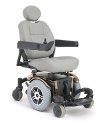 A mid-wheel drive power chair, on the other hand, has three sets of wheels and is driven by the middle set of wheels. This main advantage of a mid-wheel drive power chair is that it is very maneuverable, which results in a smaller turning radius than rear wheel drive system. However, the weight distribution is not as even on a mid wheel drive system, as the middle set of wheels supports the most weight. This makes them not quite as stable as a rear wheel drive system, but an excellent choice for indoor use, because mid-wheel drive wheelchairs are so very maneuverable.
A mid-wheel drive power chair, on the other hand, has three sets of wheels and is driven by the middle set of wheels. This main advantage of a mid-wheel drive power chair is that it is very maneuverable, which results in a smaller turning radius than rear wheel drive system. However, the weight distribution is not as even on a mid wheel drive system, as the middle set of wheels supports the most weight. This makes them not quite as stable as a rear wheel drive system, but an excellent choice for indoor use, because mid-wheel drive wheelchairs are so very maneuverable.
Portable Power Chairs vs Standard Power Chairs
Deciding whether to go with a portable power chair or a standard power chair is also an important consideration and depends a great deal on the needs of the user and where the electric wheelchair will be used.
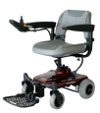 Portable power chairs, which are also sometimes called travel power chairs, are designed so that they can be taken apart into several easy to manage pieces. These individual pieces are light enough that they can usually be lifted by most people, so that the wheelchair can be transported without using a vehicle wheelchair lift. However, it is important to note that even though portable power chairs are designed to be as light as possible, the heaviest piece is usually around fifty pounds, so some might still find this too heavy to lift.
Portable power chairs, which are also sometimes called travel power chairs, are designed so that they can be taken apart into several easy to manage pieces. These individual pieces are light enough that they can usually be lifted by most people, so that the wheelchair can be transported without using a vehicle wheelchair lift. However, it is important to note that even though portable power chairs are designed to be as light as possible, the heaviest piece is usually around fifty pounds, so some might still find this too heavy to lift.
In order to reduce weight, portable power chairs have reduced features, such as smaller seats, and also typically have a slightly lower top speed, range, and weight capacity.
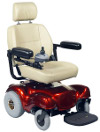 Standard Power Chairs, on the other hand, weigh a great deal more than portable power chairs and typically require a vehicle wheelchair lift to transport. Standard power chairs can typically still be easily disassembled, but the individual pieces are typically heavier than those of a portable power chair, with the heaviest piece usually weighing around ninety pounds.
Standard Power Chairs, on the other hand, weigh a great deal more than portable power chairs and typically require a vehicle wheelchair lift to transport. Standard power chairs can typically still be easily disassembled, but the individual pieces are typically heavier than those of a portable power chair, with the heaviest piece usually weighing around ninety pounds.
While standard power chairs are not as easily transported without a vehicle wheelchair lift, they are typically more comfortable and include more features. Standard power chairs usually have a more comfortable chair, a higher per-charge range, higher top speed, and a greater weight capacity than travel power chairs.
Increasing Accessibility With a Power Chair
Tuesday, August 11th, 2009
Today, many of those who use wheelchairs, opt to go with a electric wheelchair. Electric wheelchairs, which are also called power chairs, are popular for a number of reasons, including the fact that they can be operated with very little physical effort on the part of the wheelchair user.
Power chairs are not exactly a new invention and have been used for over fifty years. Back then, however, power chairs were simply manual wheelchairs that had been outfitted with an electric motor. The E & J Manual Wheelchair, which was incredibly popular at the time, actually had several do-it-yourself converter kits, which were sold to consumers, so they could transform their manual wheelchair into an electric wheelchair.
Today, power chairs remain to be very popular, but most do not share the same design as that of a manual wheelchair. Instead, most modern power chairs have a small plastic molded base, which contains the electric motor, axles, batteries, and other electrical components. A chair, often referred to as the captain’s chair, is attached to the base and often looks more like an office chair, complete with armrests, extra padding, headrest, and in some cases a reclining backrest.
Understanding Electric Wheelchair Controls
While the overall design of the power chair has greatly changed since it was first invented over fifty years ago, one thing that is still very similar is the default control system. The standard control system on electric wheelchairs is a joystick control that is attached to one of the chair’s armrest. This allows the power chair to be moved in any direction by the push of a button. However, unlike the original electric wheelchairs, modern wheelchairs also have a throttle setting to control the speed of the wheelchair. They are also much more sensitive than the first wheelchair controls, deftly turning and controlling the wheelchair in a very fluid motion.
While the joystick control system is the default control for most electric wheelchairs, there are many people who are unable to use it. For these people, a number of alternate controls are available, which can allow the power chair to be easily controlled even by people who are unable to move their hands.
Many of the popular alternate wheelchair controls are based around using the head. There are systems that allow the wheelchair to be controlled by head movements and also some that use the individuals breath to move the wheelchair. There are also a great number of experimental wheelchair controls in the works. This includes using magnets on the persons tongue and even several that rely on a brain computer interface, which uses signals from the users brain to control the electric wheelchair.
In addition to alternate control systems that make it easier for the wheelchair user to control their wheelchair, there are also a number of control schemes intended to make it easier for caretakers to move the wheelchair. The most basic is a simple remote control, either wireless or directly attached to the wheelchair, which can be used by someone walking next to the power chair. There are also much more advanced systems, which can learn the floor plans of a home or other area and then be programmed to move the wheelchair to any area in the home.
Electric wheelchairs are very powerful tools and remain to be one of the most popular accessibility tools. While these devices have been around for over fifty years, modern power chairs are much more reliable, durable, and powerful than their predecessors.
Modern Power Chairs
Wednesday, August 5th, 2009
 Electric wheelchairs, or power chairs, are today a very important accessibility aid that greatly improves the lives of millions of people every year. While modern power chairs offer similar functionality to the first electric wheelchairs developed almost 60 years ago, their design and reliability has changed a great deal.
Electric wheelchairs, or power chairs, are today a very important accessibility aid that greatly improves the lives of millions of people every year. While modern power chairs offer similar functionality to the first electric wheelchairs developed almost 60 years ago, their design and reliability has changed a great deal.
Power Chair Range and Speed
One of the biggest changes to the modern power chair is that it now uses a much stronger and more reliable electric motor. The batteries are also much improved, offering a much greater per charge distance. This not only means the wheelchair can be driven further faster, but also that it can support more weight and preform better over uneven terrain. It is not uncommon for an electric wheelchair to be able to travel more than 10 miles on a single charge, with a number of power chairs having a range between 15 and 20 miles. The top speed is also significantly higher, with most power chairs traveling at speeds at or above 5 miles per hour.
General Power Chair Design
While from a functionality and reliability standpoint, having an improved electrical system is one of the biggest differences between modern electric wheelchairs and their predecessors, there are also a significant number of changes involving the design of the device. The original electric wheelchairs were simply manual wheelchairs that had been outfitted with an electric motor and battery. However, today, most electric wheelchairs share a much different design.
This includes a much smaller molded plastic base, which contains the electrical components of the wheelchair. A seat is installed upon this plastic base and is usually referred to as the captain’s chair. Depending on the type of wheelchair, the captain’s chair could be relatively small, or it could resemble a high end office chair, with a high back and extended armrests. In either case, it is much different than the chair used on most manual wheelchairs, which is made out of slats of vinyl.
Power Chair Controls
There are in fact a great number of improvements and changes that have been made to the power chair over the years, many of these mechanical, but the standard electric wheelchair control scheme is the same. This is of course the joystick control system, which is found on most electric wheelchairs. The joystick is attached to the armrest of the wheelchairs chair and allows the power chair to be controlled by only the push of a finger.
There are also a number of alternate wheelchair controls that are commonly used, made available for people who are not able to physically able to use a standard joystick control scheme. There are many different types of controls, often aided by computers, allowing power chairs to be controlled by the angle of ones head, an individuals breath, or other parts of their body’s. For caretakers, there are also several popular remote control systems that can be attached to a standard power chair, allowing the unit to be controlled by someone walking behind it.
Even though the modern power chair shares a number of similarities with the first electric wheelchairs in regards to the functionality, they are actually quite different. Not only do they have a completely different design, but the modern power chair is much more reliable and durable.